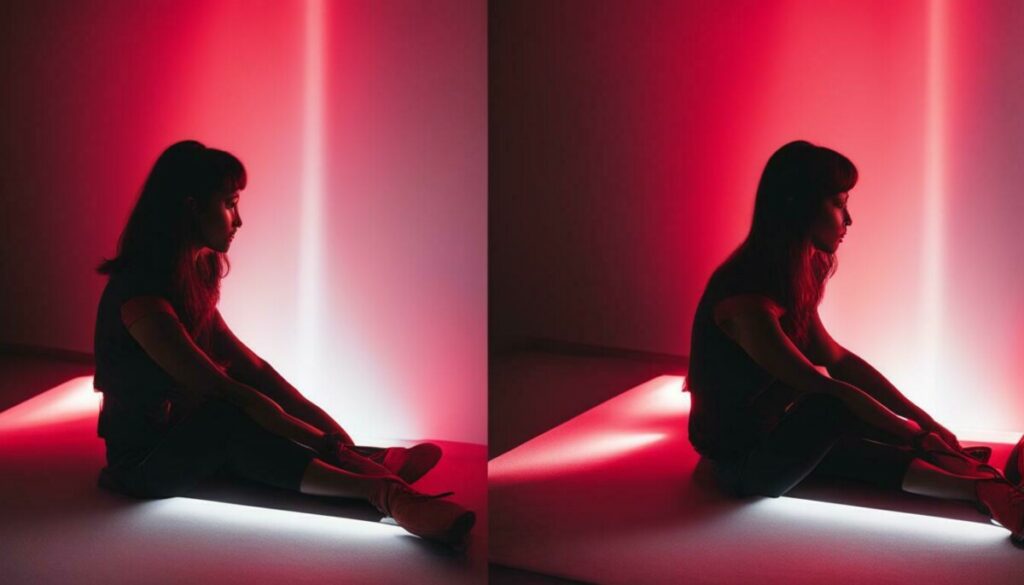Last Updated on 6 months by Francis
When it comes to light therapy, two sources stand out: red light therapy and natural sunlight. Both have been touted for their potential health benefits, but what exactly are the differences between them? In this article, we will dive into the science-backed information to uncover the truth behind these two forms of light therapy. We will compare red light therapy to natural sunlight and explore their respective benefits, differences, and impacts on health.
Red light therapy involves exposing the skin to low levels of red and near-infrared light. It is believed to help with a variety of health conditions, from reducing inflammation and pain to improving skin health and promoting wound healing. On the other hand, natural sunlight is a primary source of vitamin D, essential for bone health, mood regulation, and immune function. However, excessive sun exposure can also lead to skin damage and cancer.
So, which light therapy is right for you? Let’s explore the benefits and drawbacks of each.
Contents
Key Takeaways:
- Red light therapy and natural sunlight are two sources of light therapy that have unique benefits and considerations.
- Red light therapy works by exposing the skin to low levels of red and near-infrared light and is believed to help with inflammation, pain, and skin health.
- Natural sunlight is a primary source of vitamin D, essential for bone health, mood regulation, and immune function, but excessive sun exposure can lead to skin damage and cancer.
- The choice between red light therapy and natural sunlight ultimately depends on individual goals, health conditions, and lifestyle preferences.
- It is essential to consult with healthcare professionals and make informed decisions based on scientific evidence.
The Basics of Red Light Therapy
Red light therapy (RLT) is a form of light therapy that uses red low-level wavelengths of light to stimulate the body’s natural healing processes.
One of the primary benefits of RLT is its ability to boost collagen production, which improves skin health and reduces the appearance of wrinkles and fine lines. RLT may also help reduce inflammation, improve joint health, and aid in the recovery of musculoskeletal injuries.
RLT is non-invasive and does not produce heat, making it a safe and painless treatment option for many individuals. It can be used for a wide range of health and wellness concerns, including acne, psoriasis, and arthritis.
Despite its many benefits, it is important to note that RLT is not a cure-all and may not be suitable for everyone. Some potential disadvantages of RLT include the need for consistent and prolonged sessions to see results and the potential for overuse or misuse of RLT devices.

The Power of Sunlight
Sunlight is a powerful source of energy that has numerous benefits for our overall health and well-being. Moderate exposure to sunlight can boost our mood, improve our sleep patterns, and even play a crucial role in the production of vitamin D, a vital nutrient for strong bones and a healthy immune system. However, as with any source of energy, there are also potential risks associated with excessive sun exposure that should be considered.
The Benefits of Sunlight
One of the primary benefits of sunlight is its role in vitamin D production. When our skin is exposed to UVB rays from sunlight, it triggers a chain reaction that ultimately results in the synthesis of vitamin D in our bodies. Vitamin D is essential for the absorption of calcium and phosphorus, which are necessary for strong bones and teeth. Sunlight also plays a crucial role in regulating our circadian rhythm, which helps us maintain a regular sleep-wake cycle.
In addition to these benefits, sunlight has also been shown to improve our mood and overall sense of well-being. Exposure to sunlight stimulates the production of serotonin, a neurotransmitter that regulates our mood and helps us feel calm and focused. This is why we often feel more alert and energized on sunny days!
The Risks of Sunlight
While moderate exposure to sunlight has numerous benefits, excessive exposure can lead to various health risks. One of the most significant risks associated with sun exposure is the development of skin cancer. Ultraviolet (UV) radiation from the sun damages our skin cells’ DNA and increases our risk of developing skin cancer over time. Other risks associated with excessive sun exposure include premature aging, sunburn, and eye damage from UV radiation.

It is essential to take precautions to protect ourselves from these risks when spending time in the sun. This includes wearing protective clothing, applying sunscreen with at least SPF 30, and seeking shade during peak UV hours (typically between 10 am and 4 pm).
The Bottom Line
Sunlight is a powerful source of energy that has numerous benefits for our health and well-being. However, it is crucial to be mindful of the potential risks associated with excessive sun exposure and take precautions to protect ourselves when necessary. By striking a balance between the benefits and risks of sunlight, we can harness its power to improve our overall health and well-being.
Red Light Therapy vs Sunlight: Key Differences
While both red light therapy and natural sunlight have positive impacts on health and wellness, they differ in wavelength, intensity, and therapeutic effects. Understanding these differences can help individuals choose the most suitable form of light therapy for their specific needs.
Wavelengths
The wavelengths of red light therapy and natural sunlight differ significantly. Red light therapy uses wavelengths between 630 and 700 nanometers (nm). In contrast, sunlight contains a range of wavelengths, including ultraviolet (UV) rays and visible light.
UV rays from the sun can cause damage to the skin, including sunburn and skin cancer. Therefore, it is important to protect the skin from excessive UV exposure with sunscreen and protective clothing.

Intensity
Red light therapy devices emit low-level light, which is not as intense as natural sunlight. The intensity of natural sunlight varies depending on factors such as time of day, location, and weather conditions.
Therapeutic Effects
The therapeutic effects of red light therapy and natural sunlight differ as well. Red light therapy has been shown to improve skin health, reduce pain and inflammation, and aid in the healing process of musculoskeletal injuries.
On the other hand, natural sunlight plays a vital role in vitamin D production, improving mood and sleep patterns, as well as regulating the body’s circadian rhythm.
It is important to note that excessive exposure to natural sunlight can increase the risk of skin cancer. Therefore, moderate and safe sun exposure is recommended.
Choosing the Right Option
The choice between red light therapy and natural sunlight ultimately depends on individual goals, health conditions, and preferences. It is recommended to consult with a healthcare professional to determine the most suitable form of light therapy for each individual.
Skin Health Benefits of Red Light Therapy
Red light therapy has gained popularity for its potential benefits for skin health. This non-invasive treatment uses low-level red light wavelengths to rejuvenate and repair skin cells. Here are some of the benefits of red light therapy for skin:
| Benefit | Description |
|---|---|
| Stimulates collagen production | Red light therapy can stimulate collagen production, which is essential for maintaining skin elasticity and preventing wrinkles. |
| Reduces inflammation | Red light therapy has anti-inflammatory effects, which can help reduce redness, swelling, and irritation in the skin. |
| Helps with acne | Red light therapy can help fight acne by reducing inflammation and killing bacteria that contribute to breakouts. |
| Reduces fine lines and wrinkles | Red light therapy can reduce the appearance of fine lines and wrinkles by stimulating collagen production and improving the skin’s overall texture. |
| May help with psoriasis | Red light therapy may help ease symptoms of psoriasis by reducing inflammation and promoting skin healing. |
Overall, red light therapy can be a safe and effective option for improving skin health. However, it is important to use FDA-approved devices and follow recommended guidelines for treatment to avoid potential risks and side effects.

Skin Health Benefits of Sunlight
Natural sunlight has numerous benefits for your skin, including the ability to promote vitamin D production and regulate mood. Vitamin D is crucial for maintaining healthy skin, and regular moderate sun exposure can help keep your skin looking and feeling great.
When it comes to skin health, sunlight has been shown to have positive effects on conditions such as eczema and psoriasis. Sunlight exposure can help to soothe and alleviate symptoms of these conditions, which can be uncomfortable and sometimes painful.
However, it is essential to protect your skin from excessive sun exposure to avoid potential risks such as sunburn and skin cancer. It is recommended to limit your time spent in direct sunlight during peak UV hours and to wear sunscreen with at least SPF 30.

Overall, natural sunlight can have numerous benefits for skin health, but it is essential to balance these benefits with the potential risks of overexposure. Consult with your healthcare provider to determine the best plan for your skin health.
Red Light Therapy for Pain Relief and Inflammation
Red light therapy has been shown to have potential benefits in reducing pain levels, improving joint health, and aiding in the recovery of musculoskeletal injuries.
Many studies have demonstrated the effectiveness of red light therapy in treating pain and inflammation. One study found that red light therapy significantly reduced pain levels and increased range of motion in participants with knee osteoarthritis. Another study showed that red light therapy was effective in reducing pain associated with fibromyalgia.
Red light therapy has also been shown to improve joint health. A study on patients with rheumatoid arthritis found that red light therapy improved joint pain and stiffness. Additionally, red light therapy has been shown to improve muscle recovery time after exercise, making it popular among athletes and fitness enthusiasts.
While red light therapy has many potential benefits, it is important to use it safely and under the guidance of a healthcare professional. Overexposure to red light therapy can lead to potential eye damage and skin burns, so it is important to follow the recommended usage guidelines and safety precautions.

Sunlight and Mood Regulation
Sunlight is not only essential for vitamin D production, but it also plays a crucial role in regulating mood. Exposure to natural sunlight can boost serotonin levels and improve mood.
Serotonin is a neurotransmitter that contributes to feelings of well-being and happiness. It helps regulate mood, appetite, and sleep patterns. Many studies have found that lower serotonin levels are associated with depression and anxiety disorders.
Exposure to natural sunlight can increase serotonin levels in the brain, which can lead to improved mood and mental well-being. This is particularly relevant for individuals with seasonal affective disorder (SAD), a type of depression that typically occurs during the winter months when there is less sunlight.
One study found that daily exposure to bright light therapy, a type of light therapy that mimics natural sunlight, led to a significant improvement in symptoms of depression among SAD patients. Similarly, another study found that exposure to natural sunlight during the day led to better sleep quality and improved mood among office workers.
Overall, the benefits of natural sunlight for mood regulation are clear. Whether through spending time outside or utilizing light therapy devices, exposure to sunlight can have a significant impact on mental well-being.

Safety Considerations for Red Light Therapy
As with any form of therapy, it is crucial to understand and adhere to the safety considerations associated with red light therapy. While generally considered safe, improper use or overexposure can result in adverse effects.
The FDA has approved several types of red light therapy devices, but it is essential to use only FDA-approved equipment to ensure safety and efficacy. Using unapproved devices can result in burns or other skin damage.
Individuals with light-sensitive conditions, such as lupus or porphyria, should avoid red light therapy as it may trigger symptoms. Pregnant women should also avoid red light therapy as there is limited research on its effects on fetal development.
Overexposure to red light therapy may result in skin damage, including burns, rashes, and dryness. It is crucial to follow the manufacturer’s instructions and limit exposure to the recommended duration and intensity.

While red light therapy has numerous potential benefits, it is crucial to consider the potential risks and use caution when incorporating it into your health and wellness routine.
Sunlight and Skin Cancer Risks
While natural sunlight has numerous benefits for overall health, it is essential to consider the potential risks associated with overexposure. One of the most significant risks of excessive sun exposure is an increased risk of skin cancer.
According to the American Cancer Society, skin cancer is the most common type of cancer in the United States, with over 5 million cases diagnosed each year. Prolonged exposure to UV radiation from the sun can damage skin cells and increase the risk of developing skin cancer.
It is crucial to take measures to protect your skin from the harmful effects of the sun, such as wearing protective clothing, seeking shade during peak UV hours, and using sunscreen with at least SPF 30. Individuals with fair skin, a history of sunburns, or a family history of skin cancer may be at particularly high risk and should take extra precautions.

While sunlight can offer numerous benefits for overall health, it is important to enjoy it in moderation and take steps to protect your skin and prevent potential health risks.
Choosing the Right Light Therapy for You
It can be challenging to decide between red light therapy and natural sunlight. Ultimately, the choice depends on your personal preferences and health concerns. Here are some factors to consider:
- Red light therapy is convenient and can be done in the comfort of your own home. Natural sunlight requires you to spend time outdoors or near a window.
- Red light therapy devices are available in various sizes and strengths. Natural sunlight varies in intensity depending on the time of day and weather conditions.
- Red light therapy can be used for targeted applications, such as skin rejuvenation or pain relief. Natural sunlight has a broader range of benefits but also carries higher risk factors, such as skin cancer.
It is essential to consult with a healthcare professional before starting any light therapy regimen. They can help you determine the best approach based on your specific needs.
If you have light-sensitive conditions or are pregnant, red light therapy may be a safer option than natural sunlight. On the other hand, if you are looking for the mood-boosting benefits of sunlight or need to increase your vitamin D levels, natural sunlight may be a more suitable option.
Remember, both red light therapy and natural sunlight have their unique advantages and limitations. The choice between the two ultimately depends on your goals and individual circumstances.
Planning Your Light Therapy Sessions
Whether you choose red light therapy or natural sunlight, it is crucial to plan your sessions thoughtfully. Consider the following:
- Schedule your light therapy sessions when it is convenient and comfortable for you. Avoid times when you feel rushed or stressed.
- Start with short exposure times and gradually increase as your body adapts. Overexposure to either red light therapy or natural sunlight can have adverse effects.
- Use protective equipment when necessary, such as goggles for red light therapy or sunscreen for natural sunlight.
With the right approach, light therapy can be a useful tool to support your overall health and wellness.

The Future of Light Therapy
Both red light therapy and natural sunlight have shown great potential for improving health and wellness, and the future of light therapy looks bright. Ongoing research is exploring new applications and expanding our understanding of how light impacts the body.
One area of interest is the use of light therapy for mental health conditions like depression and anxiety. Studies have shown positive results in using red and blue light therapy for mood regulation, and future research may uncover more benefits for those with mental health concerns.
Another area of focus is using light therapy for pain management in chronic conditions like fibromyalgia and arthritis. Red light therapy has shown promise in reducing pain levels and inflammation, and further studies may explore its ability to improve joint function and mobility.
The use of specific light wavelengths in light therapy is another area of investigation. Researchers are exploring the potential benefits of using narrow-spectrum light, which may have more targeted effects on the body than broad-spectrum light. This may lead to more personalized light therapy treatments based on individual needs and health concerns.
As we continue to learn more about the benefits of light therapy, new technologies and devices are emerging to improve the accessibility and efficacy of treatments. For example, wearable light therapy devices are becoming more common and may offer a convenient and effective way to incorporate light therapy into daily routines.

The future of light therapy is bright, and we can expect to see more applications and advancements in both red light therapy and the use of natural sunlight for health and wellness. As we continue to uncover the science-backed benefits of light therapy, it is essential to use these treatments safely and responsibly to optimize their potential benefits.
Conclusion
After exploring the benefits, differences, and impacts of red light therapy and sunlight, it is evident that both sources of light have their unique advantages and considerations. The choice between red light therapy and natural sunlight ultimately depends on individual goals, health conditions, and lifestyle preferences.
Consult with Healthcare Professionals
It is essential to consult with healthcare professionals to make informed decisions based on scientific evidence. This article provides general information on the benefits and drawbacks of red light therapy and sunlight. However, it is crucial to seek professional advice before beginning any new treatment or making significant changes to one’s lifestyle.
Consider Individual Goals and Health Conditions
Individual goals and health conditions also play a significant role in determining which light therapy option is best. For example, red light therapy may be beneficial for those with skin conditions like acne or for individuals seeking pain relief. In contrast, natural sunlight may be preferable for those with vitamin D deficiencies or seeking mood regulation benefits.
Stay Safe
Regardless of the chosen light therapy option, it is crucial to stay safe. For red light therapy, it is essential to use FDA-approved devices and adhere to safety guidelines. For sunlight, it is important to practice sun protection measures and avoid excessive exposure to prevent potential risks like skin cancer.
Future Prospects
The future prospects of light therapy are exciting, with ongoing research and advancements in both red light therapy and the understanding of sunlight’s impact on health. Emerging technologies are promising, offering new therapeutic applications for both red light therapy and sunlight.
Ultimately, the decision to use red light therapy or natural sunlight is a personal one, with benefits and considerations for both. By consulting with healthcare professionals, considering individual goals and health conditions, and staying safe, individuals can make informed decisions to optimize their health and wellness.
FAQ
What is red light therapy?
Red light therapy is a non-invasive form of light therapy that utilizes low-level red light wavelengths to stimulate cellular function and promote healing and rejuvenation in the body.
How does red light therapy work?
Red light therapy works by penetrating the skin and stimulating mitochondria, the powerhouse of cells, to increase energy production. This leads to various therapeutic effects, such as improved circulation, collagen synthesis, and reduced inflammation.
What are the benefits of red light therapy?
Red light therapy has been shown to promote skin health, reduce pain and inflammation, improve mood and mental well-being, and aid in muscle recovery. It also has potential applications in wound healing and hair growth.
Are there any disadvantages to red light therapy?
While red light therapy is generally considered safe, some potential disadvantages include the need for regular sessions to maintain results and the possibility of skin irritation or eye damage if proper precautions, such as wearing protective goggles, are not taken.
What are the advantages of natural sunlight?
Natural sunlight is a rich source of vitamin D, which plays a crucial role in bone health, immune function, and mood regulation. Sunlight exposure can also improve sleep patterns, boost serotonin levels, and enhance overall well-being.
Are there any disadvantages to sunlight?
Excessive sun exposure can increase the risk of skin cancer and premature skin aging. It is essential to practice sun safety measures, like wearing sunscreen and seeking shade during peak UV hours, to minimize these risks.
How does red light therapy differ from natural sunlight?
Red light therapy primarily focuses on specific wavelengths of red light, while natural sunlight contains a broader spectrum of light. Red light therapy typically involves targeted applications, whereas sunlight exposure is more comprehensive. Both have unique therapeutic effects on the body.
Can red light therapy benefit skin health?
Yes, red light therapy has been found to stimulate collagen production, reduce inflammation, and improve various skin conditions such as acne, wrinkles, and psoriasis.
What are the skin health benefits of sunlight?
Moderate sun exposure can aid in vitamin D production, which is essential for maintaining healthy skin. Sunlight exposure may also have positive effects on conditions like eczema and psoriasis.
Can red light therapy help with pain relief and inflammation?
Yes, red light therapy has shown potential for reducing pain levels, improving joint health, and aiding in the recovery of musculoskeletal injuries. It may also have anti-inflammatory effects.
Does sunlight impact mood regulation?
Sunlight exposure has been linked to improved mood and mental well-being. It can increase serotonin levels, which are associated with feelings of happiness and well-being. Sunlight exposure may be particularly beneficial for individuals with seasonal affective disorder (SAD).
Are there any safety considerations for red light therapy?
It is important to use FDA-approved red light therapy devices and follow the manufacturer’s instructions. Overexposure to red light therapy may cause skin irritation, and certain individuals, such as pregnant women and those with light-sensitive conditions, should consult with healthcare professionals before use.
What are the risks of excessive sun exposure?
Excessive sun exposure can increase the risk of skin cancer, including melanoma. It is crucial to protect the skin by using sunscreen, wearing protective clothing, and seeking shade during peak UV hours.
How can I choose the right light therapy for me?
The choice between red light therapy and natural sunlight depends on your specific health concerns, availability, and personal preferences. It is advisable to consult with healthcare professionals to determine which form of light therapy is most suitable for you.
What does the future hold for light therapy?
Ongoing research and advancements in both red light therapy and the understanding of sunlight’s impact on health are shaping the future of light therapy. Emerging technologies and potential therapeutic applications are being explored to further enhance the benefits of light therapy.








